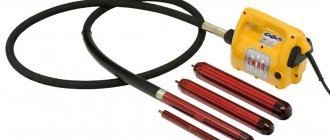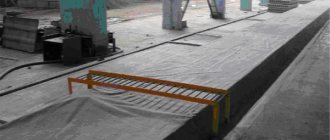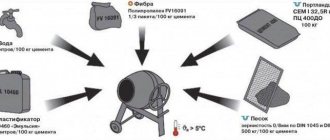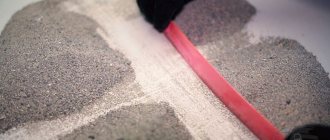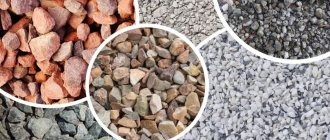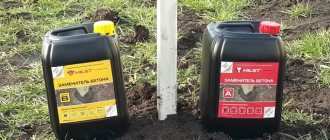To improve technological characteristics, concrete fiber is used. Adding a specific component to a cement-concrete mortar helps extend the operational life of a monolithic structure and improve the quality of load-bearing building elements. Fiber is added to the concrete composition both at the time of production of the custom-made solution, and individually before work.
general characteristics
Pipes reinforced with glass fiber create serious competition with analogues reinforced with aluminum foil. Such risers are characterized by a three-layer structure: polypropylene - fiberglass - polypropylene. The reinforcing layer is also made from propylene, reinforced with fiberglass - glass fibers. In terms of its technical parameters, the adhesion of plastic to glass fibers can be compared to the strength of a monolith.
Glass fiber reinforced pipes are characterized by the following marking: PPR-FB-PPR.
If we compare risers with aluminum and fiberglass frames, the first option has one significant advantage: the products have greater rigidity. This means that when installing systems 1.5 meters long or more, such risers must be secured to the walls with special fasteners. Otherwise, sagging, deformation, and failure of the structure are possible.
Regarding diameters, it should be noted that products can be produced with diameters from 20 mm to 110 mm. It is these risers that can be found on sale more often than others. Although, for example, elements with a diameter of 17 mm or less are used to install heated floors.
Products of small diameters are secured with plastic clips, and large ones with clamps.
Results
Glass fiber is an excellent material for dispersed reinforcement of concrete and building mixtures. It perfectly eliminates their disadvantages. But today the market offers more modern fiber options that allow you to select fiber for specific tasks and are applicable both in finishing works, such as plastering, screeds, and in the work of the main stage of construction - shotcrete, pouring structural elements of residential and industrial buildings.
If you are interested in the benefits of using polymer fiber fiber, you can contact us at the numbers listed in the “contacts” section. You will be pleasantly surprised how much the use of polypropylene fiber will improve and facilitate construction work.
Polypropylene products
The technical characteristics of glass fiber reinforced polypropylene pipes depend on the polymer used for their manufacture. All products are marked, which makes it possible to immediately determine the areas of use of tubular parts.
Let's find out what the markings on the pipes mean. So, PPR is an English name, and PPR is a Russian name meaning that this is a Polypropylene pipe made from Random copolymer.
Such fiberglass-reinforced polypropylene pipes are used for heating, water supply systems, ventilation systems, and industrial pipelines.
When arranging utility networks, fiberglass-reinforced PPR pipes are increasingly being used. There is nothing strange in this, since they are reliable, quite lightweight, and there are significantly fewer problems with their installation.
Another important factor is cost. For example, the price of PPR pipes reinforced with glass fiber for heating is lower than their metal counterparts, which helps save the family budget. These, as well as other characteristics possessed by fiberglass-reinforced polypropylene pipes, contributed to its popularization and use in various spheres of the national economy.
With this article read: Main characteristics and scope of application of polypropylene pipes, diameter and what influences its choice. Classification by pressure and composition of raw materials. Polar questions and answers to them.
Material consumption
In each specific case, the fiber consumption is different. This is explained by different areas of operation of the finished structure and different levels of force and mechanical impact. Fiber consumption for building mixtures is presented in the table:
| Product type | Consumption per cubic meter of cement-concrete composition in kg |
| Concrete with a porous structure | 0,6—0,9 |
| Concrete screed | 1,8—2,7 |
| Small architectural form | |
| Concrete for road surfaces | 1—1,5 |
| Gypsum objects produced by casting method | 0,4—0,8 |
| Dry composition | 0,6—0,9 |
| Artificial stones | 0,4—0,8 |
| Facade cladding |
What types of polymer pipes are there?
Currently, 2 types of polymer products are known:
- single-layer;
- multilayer.
What characteristics do each type of product have?
Single layer
There are 4 modifications of polypropylene risers of one-piece construction, used for heating or water supply.
1st type: PPN pipes.
Homopolypropylene is used for their production. They are used in engineering pipeline structures for supplying cold water, arranging ventilation, and industrial pipelines.
2nd type: RRV pipes.
The basis for production is polypropylene block copolymer. The products are intended for installation of underfloor heating and cold water supply networks.
3rd type: PPR pipes.
The material for the production of parts is random polypropylene copolymer. The main property of the substance: promoting uniform distribution of loads on the internal walls of pipelines.
Hot and cold water supply, underfloor heating systems, water radiator heating - this is a list of applications for risers of this type.
4th type: PPs pipes.
The main characteristics of the products: polypropylene with increased heat resistance is used for production.
The parts of such a line are able to withstand temperatures of transported media up to +95⁰С. If necessary, it is possible to transport media with temperatures up to +110⁰C for a short period of time.
The first three analogues are designed to operate at temperatures around +70⁰С. In short-term mode, operation is allowed at slightly higher temperatures.
Products of the 3rd type are covered with a special shell, which can completely eliminate the negative effects of ultraviolet radiation.
Important! You should not often use the system operation in the maximum permissible parameters mode.
About multilayer analogues
Polypropylene (PP) pipes consisting of several layers are reinforced with fiberglass and are used for heating and water supply. Compared to solid cast structures, PP products practically do not change their linear dimensions at high temperatures of the transported media. Thanks to this property, the scope of application of solid-cast communications is significantly expanding.
The following modifications of multilayer risers can be distinguished.
1. Products for the reinforcement of which perforated aluminum foil is used.
They are characterized by the presence, on the outer or middle layer, of small diameter holes in the form of a mesh. The strength of the connection with the polymer is achieved due to the viscosity and fluidity of the substance that penetrates into the holes of the aluminum layer.
Product advantages
- Low coefficient of linear expansion;
- increased strength.
Minuses
- During the welding process, it is quite reliable to connect only the top layer of the riser to the fittings;
- aluminum reinforcement must be removed before welding, since failure to perform this operation may cause a poor-quality connection.
PP pipes with reinforcement in the form of solid aluminum foil.
The foil can be located both on the outer and on the middle layer of the pipe part, but it is imperative that polymer layers are placed on both sides of the metal.
Before you start welding, you need to trim the risers. Thanks to the procedure, the possibility of contact of aluminum with a moving medium is eliminated.
Advantages
- Low coefficient of thermal expansion;
- increased strength properties.
The disadvantages include:
- not all layers are welded reliably. In welding areas, only the outer layer is absolutely reliable;
- mandatory removal of unnecessary aluminum residues, which takes a lot of time.
Important! To remove the aluminum layer before welding, you need to use a special tool. Its purpose: to accurately measure the depth to which the pipes should be lowered into the fittings in order to clean the inner surface to the same distance.
Failure to comply with this condition can lead to an unreliable connection, which is fraught with the occurrence of electrochemical processes when the foil comes into contact with water.
Some enterprises have mastered the production of communications of this type, the design of which does not provide for preliminary cleaning before welding.
PP products with polyethylene reinforcement.
That is, the outer layer of the pipe looks like a thick polyethylene layer.
Advantages
- Low coefficient of thermal expansion;
- no cleaning required before joining by welding;
- operation at high temperatures.
Minuses
- When joining, a reliable connection of the fitting is possible only with the outer layer;
- full contact of the transported medium and polyethylene is not excluded;
- strength characteristics want to be the best, since the layers are connected to each other using glue.
PP pipe with glass fiber reinforcement.
Design feature: the presence of a middle polypropylene layer filled with fiberglass. Fillers are often colored to make them better visually distinguishable.
The advantages of this type of communication are greater than those of previous analogues combined.
Firstly:
structures with pipes reinforced with fiberglass for heating or water supply are highly durable and solid.
Secondly:
Fiberglass-reinforced risers are characterized by a relatively low coefficient of thermal expansion, which is approximately 25% less than that of non-reinforced counterparts.
Third:
Before hot joining, there is no need to clean the ends of the elements being connected.
Fourth:
The fiberglass line has increased rigidity.
Fiberglass elements have one drawback, and even that has not yet been fully proven: the penetration of oxygen through the material.
If this fact is fully confirmed, an accelerated process of corrosion of the metal from which the boilers are made is possible.
Theoretically, such a disadvantage is possible, but in practice, research is still being carried out.
Installation features
The basics for installing reinforced pipes are the same as for unreinforced ones. The assembly of plumbing or heating is done by cutting blanks and soldering them with fittings.
For this work, there is a special soldering iron that heats the pipe and fitting, and when they are connected together, a monolithic structure is obtained that eliminates leaks.
The only rule if you are working with aluminum reinforced polypropylene is to strip the pipe. For this technological operation, there are also special devices - a small coupling or a trimmer.
If the aluminum layer is on the outside, use a coupling with knives. A pipe is inserted into it and turned 2-3 times. The trimmer is useful with those workpieces in which the reinforcing layer is located inside.
These actions are necessary to allow the polypropylene pipe to better bond to the fitting.
They also guarantee better resistance to delamination and corrosion, which can occur as a result of electrochemical processes at high temperature and pressure.
How elements are connected to each other
PPR pipes reinforced with glass fiber can be joined into a single structure by diffusion welding or fittings (adapters, couplings, tees and other parts).
Each method uses a special soldering iron, the so-called welding machine. The risers joined in this way create a monolithic, non-demountable structure.
The presence of special adapters in the form of threaded or flanged connections makes it possible to fasten a PPR polypropylene pipe reinforced with glass fiber to a metal line corresponding to the fittings.
Is it possible to completely replace fiberglass with steel analogues?
Reinforcing rods are a new, little-studied material on the construction market. Users who have worked with raw materials can give recommendations for use.
It is better to use composite reinforcement to strengthen the structure of brick and block walls. For connecting an interior wall with a partition (for example, when constructing a wall from gypsum boards).
Strip foundation
The superiority of fiberglass reinforcement over steel is its resistance to corrosive destruction. Low heat capacity (when located in a concrete structure, it does not create cold bridges, unlike metal rods).
It is recommended to use fiberglass rods when building low houses on dense soils with high stability.
What is a fiberglass reinforced polypropylene pipe?
These products are 3-layer polypropylene pipes reinforced with FIBER glass fiber.
They differ:
- increased resistance to corrosion processes and chemical influences;
- abrasion resistance;
- hygiene. Thanks to this property, the products have found their application in the installation of drinking water pipelines;
- environmental safety;
- long service life;
- ease of installation.
In addition, the products are universal in their use.
This is manifested in the fact that they are used:
- when installing heated floors, water heating;
- for supplying hot and cold water;
- in the process of arranging drainage and sewer systems.
Due to the design features of the risers, the product practically does not change its linear dimensions, which is very important when installing heating and ventilation communications.
Scope of application
Reinforced pipes made of polypropylene are used for installation:
- heating systems for autonomous and centralized purposes;
- water supply with hot water;
- communications at industrial enterprises, allowing the movement of aggressive media and liquid substances for food use.
Most often the products are purchased by homeowners. After all, it meets modern requirements. The products have a long service life. This is of great importance when installing heating circuits in private homes.
Moreover, systems made of polypropylene pipes with fiberglass or aluminum can be independently installed, easily maintained and even repaired.
It is not recommended to use reinforced steel to create centralized heating systems in cold regions.
Significant temperature differences and heavy loads negatively affect the durability of networks made of rolled pipes reinforced with aluminum foil or glass material.
How to choose the right one
This question is asked by everyone who deals with the arrangement of pipe structures during repairs or when building a new house. The main thing is that the planned highway is of high quality and cheap.
To optimally resolve the issue, you need to have knowledge of the technical characteristics of the system that you plan to build.
Experts advise adhering to certain recommendations regarding other characteristics, the main ones being:
- diameter;
- pressure;
- manufacturers.
And then - in more detail.
Required diameters.
Today's market is saturated with products with diameters of 20-110 mm.
In everyday life, elements with a diameter of up to 40 mm are most often used. Risers of this thickness are used in the installation of heating, ventilation systems, hot and cold water supply.
In some cases, the most accurate calculations are needed when installing certain communications. In such situations, it is necessary to use the services of specialists who, using formulas, will make the necessary calculations. Taking into account the maximum water flow rate and the speed of its movement, professionals will tell you as accurately as possible what diameter riser should be used in a given case.
What pressure are the parts designed for?
To a person not familiar with the specifics of such work, the task of choosing a riser that can withstand a certain pressure seems quite difficult. But this is at first glance. In fact, the problem is easily solved.
To do this you need: to know what pressure the heating or plumbing system is designed for and... to be able to read. This means that since all glass fiber reinforced PPR pipes are marked, it contains all the information about the product. That's where it says what maximum pressure the product is designed for.
Mostly, in everyday life, communications with the inscription PN20 are used, which means that the part can be used in lines with a pressure of up to 20 atm. This number is exaggerated, since such pressure is not observed in household lines. For example, in heating systems of one-story buildings, the nominal pressure is 2.5 - 4 atmospheres. But a margin of safety won't hurt.
Regarding the diameter, it is necessary to select the appropriate fittings.
Important! The optimal option for selecting pipes and fittings is to have parts not only of the same diameter, but also of the same manufacturer. When installing a structure made from such elements, minimal problems are eliminated.
Manufacturers
The correct choice of PPR risers also includes the choice of manufacturer. There is no one specific company whose products would satisfy all customers.
The question is to avoid unnecessary problems. Therefore, preference should be given to that (or those) enterprises whose reputation in the market for similar goods is impeccable.
Companies from Europe have a certain advantage in this regard. High quality, reliable operation, affordable price, which means that products from companies from Germany and the Czech Republic are popular.
In recent years, the quality of goods from Turkey and China has increased significantly.
Domestic manufacturers are slightly behind them, whose products today are distinguished not only by relatively low prices, but also by proper quality. The choice is yours. The main thing is not to buy fakes. Therefore, buy goods in branded stores, requiring a quality certificate.
In addition to these, there are other reasons that influence the choice of product. There is, however, one thing: we did not remember at all about the service life of products made from white polypropylene. There is a reason for this. Adhering to the requirements of proper operation, the elements of the pipeline structure are fully capable of withstanding the period of time needed to begin the next major renovation of the building.
These are the materials today.
Advantages and disadvantages
When fiberglass for reinforcement gets into concrete, it not only serves as a support for the mixture, working almost like a skeleton in the body, but also partially gives it its properties - frost resistance, water resistance, protection from aggressive substances. Most importantly, the building mixture with fiber does not delaminate or shrink, and after gaining strength it begins to withstand tensile and bending loads much better.
But is it only fiberglass that allows one to achieve such results, or are there other options?
Manufacturing technology
The production process involves blowing thin threads from raw materials. The production of glass threads is divided into several stages:
- Melting of raw materials.
- The melt is passed through micro-holes under high pressure. This is how the material becomes thread-like.
- Cooling and winding threads onto spools.
- Treatment of finished fiberglass using a lubricant. This is necessary to make the material resistant to stretching, friction, and also provide waterproof properties.
In the production of threads, not only molten glass is used, but also round glass, which is initially melted. The use of technology significantly increases production costs.
Based on the thickness of the threads, there are: thick fiber (more than 25 microns), thickened (12-15 microns), thin (4-12 microns), ultra-thin (1-3 microns). Production is carried out taking into account the current GOSTs:
- GOST 19170-2001 (for fabrics for structural purposes).
- GOST 19907-83 (for insulating materials).
